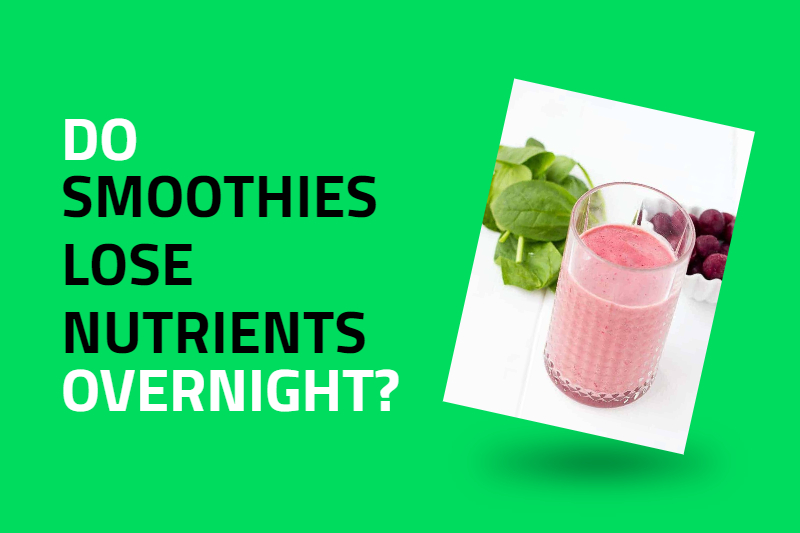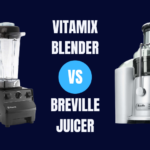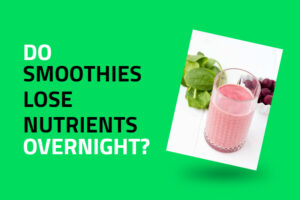One of the most frequently asked questions about smoothies is, “Do smoothies lose nutrients overnight?” People are so anxious about this that they frequently stir the smoothie before going to bed. If you store your smoothie in a tightly sealed container, such as a glass mason jar or stainless steel canning jar, it may be fine if you don’t use it every day—but what if you do? The answer is that it is dependent on the ingredients. Smoothies with a high sugar content are more likely to lose nutrients overnight while they sit in the refrigerator. However, if you make a smoothie with largely fruits and vegetables, it should be fine—and you might even receive some extra vitamins or minerals from the veggies!
Table of Contents
Waht is smoothie nutrients?
There is much dispute about whether smoothies lose nutrients over time. Smoothie nutrition is determined by how the ingredients are processed and the number of servings in each smoothie. When blended, the most nutrient-dense items, such as fruit and vegetables, will retain their nutrients the longest. However, combining fruits and veggies may not be the greatest option if you want to have a significant amount of them in one session. For example, if you drink a smoothie with six apples, three celery stalks, and a banana, each component would have a short shelf life if consumed separately. All of these components, however, would be excellent for several days if taken as part of a smoothie. Having said that, some foods lose nutrition over time. Milk and juice, for example, can be broken down into lactose and sugar, respectively. Protein powders also lose some of their substance when blended with liquid, which causes them to spoil faster.
Do Smoothies Lose Nutrients Overnight?
Smoothies are, by definition, a combination of two or more components. While it is tempting to believe that a smoothie includes no nutrients, this is not always the case. In fact, many smoothies are high in antioxidants as well as other vitamins and minerals.
While there is no scientific data to support the assumption that smoothies lose nutrients overnight, there is some anecdotal evidence to corroborate this. Over an eight-hour period, for example, one study discovered that Smoothie King smoothies lost significantly more nutrients than traditional fruit juices. Another study discovered that, as compared to eating fruit on its own, blending fruits reduced the levels of vitamin C, potassium, magnesium, and other nutrients in participants’ blood serum.
So, while smoothies may lose some vitamin content over time, this is usually not a big issue. Choose a smoothie made with whole fruits and vegetables instead if you want a nutritious drink that will still deliver benefits after being mixed for a lengthy period of time.
Why smoothies sometimes lose nutrients?
Smoothies are an excellent way to obtain your daily serving of fruits and vegetables, but they can lose nutrients over time. Smoothies sometimes lose nutrients because they are made using frozen fruit and vegetables. The freezing procedure removes some of the water and nutrients included in fruits and vegetables. So, if you create a smoothie every day for two weeks, the smoothie will most certainly have lost a lot of its vitamins and minerals by the end of the two weeks. However, if you make the same smoothie once a week for two months, it is more likely to be nutrient-rich. Juicing your favorite fruits and vegetables and mixing them with water or milk is an excellent strategy to combat this issue. Make sure you don’t over-blend the fruit and veggies or they’ll turn into a smoothie. Then, consume them as quickly as possible to ensure that all of the nutrients are still present.
How Long Before a Smoothie Losses Nutrients?
Smoothies are an excellent way to get your necessary daily consumption of fruits and vegetables, but what about the nutrients? Do smoothies lose their nutrients over time?
The quick answer is that smoothies can lose nutrients over time. Smoothies contain fruit and vegetables, which means that some of the nutrients in those foods will be leached away over time. The good news is that the majority of the nutrients in a smoothie can be easily replaced by consuming the same products as part of a balanced diet. This article examines the nutritional loss that smoothies can cause and how to minimize those losses.
How Much Protein Should I Consume? You’ve heard the adage “protein is king,” right? True, but eating too much protein may cause certain issues with your health. Learn more about how much protein is good for you, where you can acquire the recommended daily amount of protein, and what happens if you consume too much.
What Are the Best Protein Sources? If you’re seeking for the best protein sources, we’ve got you covered. We’ll help you choose your favorite protein sources and make the most of them. Best Protein Sources: What to Eat for a Healthy Body? . Pregnant Women’s Favorite Foods Protein Food Sources – Healthline The greatest protein sources in a variety of categories, including beans, nuts, seeds, and so on, are featured in a new series on Healthline. Beans, Grains, and Seeds Are the Best Nutrient-Rich Foods – VegetarianHealth.com Best Nutrient Rich Foods, a new feature on Health.com, lists the major nutrients in beans, grains, and seeds, including protein, carbs, and fiber, as well as a basic explanation of their…
Best Vegetarian Protein Sources: Beans and Lentils (A-Z) – Martha Stewart Living
Lentils are an excellent source of protein for vegans. Simply add them to soups and stews or sauté them with onions and garlic. Here’s a list of some of the best protein sources: The Best Protein Sources – Vegetarian Times According to the Vegetarian Times, the following are the top ten protein sources. Protein can be found in beans, nuts, and seeds. Beans are a great source of protein, and they usually have more… Vegan Health’s 10 Essential Proteins for Vegans & Vegetarians Vegans and vegetarians will benefit from consuming a wide variety of vital proteins, as well as some amino acids found in animal products.
freezing smoothies lose nutrients Overnight?
If you’re looking to lose weight or just want to maintain your health, it’s important to freeze your smoothies. In this blog post, we’ll discuss the benefits of freezing smoothies and how to do it without losing nutrients.
When you freeze a smoothie, you stop the natural process of nutrient loss that would take place if you drank the smoothie immediately. Smoothies are made up of fruits, vegetables, and milk or juice, which all contain different levels of antioxidants, vitamins, and minerals. When these ingredients are combined and quickly consumed, some of these nutrients will start to break down. However, when frozen for an extended period of time (overnight is ideal), these nutrients will remain intact and can be absorbed by the body more easily.
Besides preserving nutrients, freezing smoothies also makes them freezer-friendly. This means that you can store them in a container without having to worry about them thawing out and becoming icy cold again. If you’re someone who likes to drink smoothies on-the-go, this is a big bonus! Plus, since they’re already chilled before you drink them, they’re less likely to cause toothache or other oral discomfort. This is another reason why we recommend frozen smoothies for breakfast. If you’re not a morning person, it might be hard to get motivated to eat your smoothies at 6 am when you’re so hungry that nothing else will do. However, by freezing them beforehand, you can have them handy and ready to go!
how long do smoothies last in the fridge?
Smoothies are fantastic since they may be a nutritious and refreshing drink at any time of day. Smoothies, like other liquids, lose nutrients over time. Here’s how long smoothies will keep in the fridge:
Smoothies created with fresh ingredients will be more flavorful and fresh. They will also last longer than smoothies made with pre-packaged ingredients or with frozen fruits and vegetables. Smoothies made with fresh ingredients will keep in the fridge for 3-4 days on average. Those created using pre-packaged ingredients typically last 2-3 days. Because frozen smoothie textures have less liquid and ice, they tend to last longer than ones produced with fresh ingredients. These will usually keep in the fridge for 4-5 days.
The quick answer is that they normally survive four to six hours in the fridge, but they can last longer if properly packed. Make your smoothie ahead of time and keep it in a tightly sealed container to ensure that it lasts as long as possible.
When you make a smoothie, you’re actually combining fruit, juice, and milk together to form a delightful drink. All of the ingredients are quickly combined and then placed in the refrigerator to cool. Smoothies, on the other hand, can be stored in the refrigerator for up to four hours. The smoothie will get slightly sour and gritty after four hours, but it will still be safe to drink.
How To Save A Smoothie For Later?
If you’re like the majority of people, you like a smoothie or two on the move. But what if you create a smoothie and notice it’s gone sour before you’ve finished it? You can store a smoothie for later without losing any of its benefits by doing a few things.
The first thing you should do is put your smoothie in an airtight container. This will assist to preserve the tastes and nutrients. If you have enough place in the fridge, you can also store your smoothie there. This will help to keep the smoothie cold and prevent it from spoiling.
If none of these solutions appear to be excessively time-consuming or complicated, you may always freeze your smoothie. Just make sure to let it thoroughly thaw before eating it. If you have a Vitamix blender, you can easily make smoothies in the Vitamix. This ensures that no lumps or fragments of food remain when the smoothie is ready to be consumed. After you’ve brought your smoothie outside and allowed it to sit for a few minutes, add some ice cubes to it. The ice will help keep the smoothie cool, preventing spoiling or mold growth on your smoothie. Your smoothie should have the consistency of “jello,” but not quite jello… more like pudding. If you placed too much ice in your smoothie, then add some more to get it to the appropriate consistency. This will keep your smoothie cool for an extended period of time, which is always desired if you need to take your ingredients on an airline and don’t want them to spoil. I can’t tell you how many times I’ve made a smoothie just to have to dump it out because I forgot about the ice before I started sipping! If you want your smoothie to be healthy and preserve its flavor for an extended period of time, ice is a must. If you can’t find frozen fruits at your local supermarket, here are some fruits that freeze well: Nectarines, peaches, pears (fresh or dry), kiwi, sour plums, raspberries, and strawberries If you enjoy frozen fruits, you’ll enjoy the Jamba Juice Sampler Pack I recently purchased on Amazon.com! It includes 5 different types of fresh and frozen fruits in an insulated bag for simple travel. I hope this was useful for those of you who want to create smoothies at home. The advantages of making your own smoothie are numerous, ranging from receiving your daily fiber intake (fiber in fresh fruits is not the same as fiber in whole grain bread and cereal), to getting all of the vitamins and minerals your body need, to the antioxidant characteristics of particular fruits. Check out my other recipes for additional ideas on how to make healthy homemade smoothies!
Are Smoothies Still Nutritious the Next Day?
Is a smoothie still a healthy supper the next day? If you rely on frozen fruits and veggies, the answer is probably no. According to a recent study published in the “Journal of Obesity,” frozen fruits and vegetables lose up to 30% of their vitamin C, -carotene, and other minerals after blending. However, if you use whole fruits and veggies in your smoothie, you should not experience any nutrient loss. A smoothie is a terrific alternative if you’re searching for a quick and healthy snack or breakfast. What is the best way to use my NutriBullet? NutriBullet infuses foods with oxygen, removing up to 90% of the water. This contributes to the smoothness and flavor of your smoothies, drinks, and sauces. Press the Shatter Shield into the bottom of your cup or glass to make a smoothie. Pour in your preferred ingredients and start mixing with your NutriBullet. Once you’ve reached your desired consistency, remove the top and enjoy!
How to get the best nutrients from smoothies?
Smoothies are a delicious way to get your daily dosage of fruits and veggies, but how long do the nutrients stay in them? Smoothies, according to smoothie expert Elissa Epel, might be a good method to receive more vitamins and minerals than traditional diets. “Because smoothies are a complete meal in a glass, they’re a wonderful vehicle for acquiring good nutrients,” she explains. “The goal is to acquire enough of all the essential vitamins and minerals while also balancing out the sugar and calorie levels.” Here are some suggestions for making nutrient-dense smoothies:
Add a lot of fresh fruit and vegetables: Fruit and vegetables are a significant part of why smoothies are so high in nutrients. Create sure to incorporate a good amount of both in every smoothie you make.
When it comes to sweeteners, Epel advocates utilizing natural sweeteners like honey or maple syrup rather than processed sweeteners like sugar or artificial sweeteners. Both honey and maple syrup contain natural sugars that will help your smoothie’s nutritious content.
Take your time measuring: Smoothie experts recommend measuring each ingredient before putting it to the blender so you know precisely how much to add. How much do you require? “Add one-third to one-quarter cup of liquid per serving for a basic smoothie,” explains Epel. For example, if you want 16 ounces (480 ml) of smoothie, make sure the blender has at least 8 ounces (216 ml) of liquid. Slowly pour: Filling your blender too rapidly can result in more air bubbles in your smoothie, making it thinner than planned. Pour slowly, beginning at the edge of the cup and stirring as you go. You don’t want any drippage on the side of your cup to taste. Thoroughly combine: We’ve all held up a thick and impenetrable tangle of fruits and vegetables in our blended beverages that seemed like they came from another planet. Don’t do it; instead, blend them till smooth, not pureed. If you use a blender with a huge blade or a cup that is too large, it will never work perfectly. Drinking it straight soon, on the other hand, can help keep your smoothie from becoming overly thick and chunky. Increase the liquid: If your blender isn’t picking up all of the fruit in your drink, add a bit additional liquid. We like to use 1/2 cup (120 mL) of water, but you may substitute any type of milk or yogurt if that’s simpler for you. Avoid using ice because it will make your drink overly thick. Add a little more sweetener: If smoothies are too sweet for you, sweeten your drink with a little extra sweetener. Try adding 1-2 teaspoons (15-30 mL) at the start of the blending process. It’s the most natural approach to change the sweetness of your drink, and it shouldn’t have any effect on the texture.
If your blender is having problems picking up all of the fruit in your drink, add a little additional liquid. We like to use 1/2 cup (120 mL) of water, but you may substitute any type of milk or yogurt if that’s simpler for you. Avoid using ice because it will make your drink overly thick.
After mixing, add a few other ingredients such as vanilla extract, nutmeg, coconut flakes, banana slices, and so on to make various varieties of tasty smoothies. Remember to use less sweetener when making these additions.
Do You Have to Drink a Smoothie Right Away?
Smoothies, if you’re like most people, are probably thought of as a refreshing way to get your daily dose of fruits and veggies. But, how do they operate, and are they as healthy as they appear?
Smoothies are blended drinks comprised of fruit, milk, or yogurt, and ice. They are frequently high in sugar, therefore it is necessary to be aware of the nutritional content before beginning to drink them on a daily basis.
Smoothies are a wonderful source of fiber, vitamins, minerals, and antioxidants in general. However, if smoothies aren’t taken straight once, the nutrients in them might quickly lose their potency. This is due to the fact that the fruit and milk mixture soon absorbs water and begins to produce a squishy or even ice cream-like consistency. This procedure also aids in the removal of some of the nutrients and flavor from the components.
So, should you drink your smoothie immediately or wait a few hours? The answer is that it is dependent on the particular ingredients and their nutritional value. If you’re concerned about nutritional loss, it’s preferable to drink your smoothie within an hour or two of blending it. Here’s a quick breakdown of what you should drink right away with your smoothie: 1. Consume whole, fresh fruits and vegetables as soon as possible after blending. As you might expect, entire fruits and vegetables have a relatively short shelf life, so all of the nutrients and flavor that they contain will be lost if they sit in a blender or food processor for an extended period of time. 2. When making smoothies with nutrient-dense components like fruit or vegetable powders, protein powder, or nut butter, shake the contents thoroughly before adding them to the blender. Otherwise, they will begin to clump and will be difficult to combine. If you haven’t used the smoothie-making ingredient in a while (or even a few days), it’s more prone to form lumps and clumps when blending. 3. When creating fruit smoothies, make sure there is no excess water in the blender if you want the smoothest possible result. If you mix the components too well, the surplus water can form lumps and clumps. 4. The same goes for protein powders and nut butters, as well as any other ingredients you want to include in your smoothies. When adding these types of ingredients, be cautious because they might soon start forming lumps if not properly blended. 5. If you don’t clean your blender properly, it will become gunked up quickly. As a result, make it a point to clean it at least once a week. This is especially critical if you’re blending a large number of items at once. 6. As much as I dislike saying it, the more sugar you add to your smoothies, the worse they taste because the sugar becomes the main element in the majority of the flavors. So save the sweet smoothies for dessert and instead create those healthy juices. 7. If you want to utilize frozen fruit, keep in mind that some fruits tend to discolor when frozen. This is what I refer to as a “watermelon” effect. That’s why you should always defrost your fruit before combining it. 8. If you want to include a particular ingredient in your smoothie, use it sparingly or blend it into the juice first. The more ingredients that are added, the more likely it is that they will be blended away and appear in the completed product. 9. Don’t over-blend your smoothie. You don’t want it to be too thick, but neither do you want it to be like liquid yogurt. This is because the longer you blend your smoothie, the more air will be absorbed into it, and some of the thicker ingredients will float. If this happens, your smoothie will have a somewhat powdered consistency instead of being creamy; if this happens, simply mix for a few seconds longer and it should return to normal. 10. Make sure your smoothie has adequate liquid.
How can you make a smoothie healthy and nutritious?
Smoothies are an excellent method to meet your daily fruit and vegetable requirements, and they are often high in protein and low in fat. But how come smoothies lose nutrients so quickly?
The answer is that smoothies do not provide a consistent supply of nourishment. When the ingredients are blended, the nutrients in the fruits and vegetables are broken down into tiny molecules that are no longer as useful to your body. To ensure that a smoothie is healthful, drink it as soon as possible after combining it. If you create a smoothie in the morning, simply store it in a plastic container in the fridge. This allows nutrients to be reabsorbed into your body at a faster pace. If you have the time, make a large batch of fruit and vegetable smoothies. This allows you to take advantage of the fact that these items are usually extremely cheap and will be used up much less than once daily servings. Any leftover smoothies can be frozen for later use.
What to put in your smoothie?
There is no single correct answer to this question because the ingredients you choose for your smoothie will be determined by what you enjoy and what you have on hand. Fruits, veggies, yogurt, protein powder, and nuts are all common smoothie ingredients. It’s crucial to remember that smoothies are not a complete meal and should not be substituted for a well-balanced diet. They can be as healthy as you like.
I used to make smoothies using anything was in the home that needed a boost when I first started making them. When it comes to nutritional value, I’ve learnt what to add and what not to put to my smoothies over time. The most crucial thing is that the ingredients in a smoothie compliment each other—they shouldn’t taste so dissimilar that you don’t want to drink them. Because you will get the finest taste and health benefits from blending your smoothies at home, this section will focus on the method rather than the recipe. All you need to make a smoothie are some fresh ingredients and a blender or food processor. For the majority of my smoothie recipes, I use my Cuisinart SmartPower 7-Speed Hand Blender, which has excellent performance for the price. The first step is to gather your ingredients, which should include fruits, veggies, and any other things you desire in your smoothie. Basically, anything that can be consumed is suitable for inclusion in a smoothie. When I only drink one smoothie, I like to add protein (such as tofu or turkey) since it makes me feel full and content. Don’t worry if you don’t want to add protein to your smoothies. Even without the protein, drinking a fruit combination provides the same benefits. Another reason to include protein in your smoothie is that if you do not drink protein with your smoothie, you may feel hungry 30 minutes later. Protein keeps you fuller for longer, eliminating the need to prepare another meal. I used to believe that all fruit-based smoothies were excellent for you. However, I’ve now discovered that there are several fruits that have as much sugar and calories as a snack cake! It’s time to cross that fruit off your shopping list that you’re using in your smoothie. If you must include one of the fruits suggested above, limit yourself to one serving each day. For instance, if you’re combining strawberries and mangoes, use only two of each (two strawberries and a mango). If you’re having difficulties choosing the proper flavor of yogurt for you, I recommend going with the plain variety. Alternatively, you may make your own!
Do you lose nutrients when blending?
When it comes to whether smoothies lose nutrients overnight, there is no definitive answer. Part individuals assume that because smoothies are combined together and heated, they lose some of their nutritional content. Smoothies, according to some, retain nutrients because they are made with complete, unprocessed foods. To be certain, you should consult a nutritionist or a dietician.
Can you become sick by drinking smoothies? Smoothies do not make you ill, according to research. Nonetheless, fruit and vegetable quality has improved so much in recent years that they may be less likely to cause food poisoning than they were previously. In reality, according to the United States Department of Agriculture, most people may eat fresh vegetables without incident, even if it was grown in contaminated soil. However, if you are prone to food illness, such as newborns or the elderly, it is always best to avoid eating certain fruits and vegetables. Cooked foods are the safest way to consume these items. If you are unsure about the quality of your product, only wash the exterior layer. Smoothies can be produced in any ordinary blender, but a powerful machine will make them easier and more delicious. A powerful blender can be a terrific investment, especially for persons who prefer really strong flavors. The blender’s primary role is to chop and mix food, but it may also be used to prepare smoothies with a few simple steps. To begin, you must clean your fruit. This can be accomplished by peeling it and sorting it through once or twice. This technique requires a lot of patience because if you are not careful with your fruits, they will come out covered in mold. If these molds are not eradicated, all of the nutrients in your smoothie will be destroyed. If you have a blender with a tight seal, removing the molds from your fruit is a breeze. The following step is to combine all of the components in the blender. In order for the complete recipe to turn out flawlessly, you need use at least one cup of each component. It is also critical that each component be thoroughly diced or blended. You don’t want chunks of ice in your smoothie, for example, because they won’t melt correctly when blended with the other components. If you’re using frozen fruit, it’s best to let it come to room temperature for a few hours before blending it into the smoothie. After you’ve finished blending everything together, you can start preparing everything for serving the smoothie.
How to Store Your Smoothies Properly?
Smoothies are a tasty and nutritious way to receive your daily nutrients, but like any meal, they can spoil rapidly if not stored properly. Here are four smoothie storage tips:
- Keep them cold: Smoothies are refreshing on a hot day, but they spoil rapidly if kept at room temperature. For the longest shelf life, keep them in the refrigerator or freezer.
- Freeze them: If you don’t have the time or room to keep your smoothies cool, freeze them to keep them fresher for longer. Just remember to thaw them before drinking!
- Pack it in: Fill your smoothie container to the brim with smoothie so it doesn’t spoil as quickly. There should be no spaces for germs to flourish.
- Pour it out: Once your smoothie is completed, pour it into a glass and enjoy! You should try to use a glass or container that you can drink from, as plastic may cause your smoothie to taste strange. Here’s one we created:
Which fruit goes best with protein?
Because most fruits are heavy in carbohydrates, you must exercise extreme caution when selecting which ones to include in your smoothie bowl. Here are some of our favorite protein-rich fruits:
- Berries: Strawberries, blueberries, raspberries, and blueberry juice are all high in protein and can be included to your smoothie bowl.
- Avocado: Avocados are another wonderful food that adds protein and fat to a smoothie bowl.
- Pistachios: Pistachios are high in healthy fats and make an excellent addition to any drink.
- Bananas: Bananas are high in potassium, which aids in the absorption of all the nutrients in your smoothie bowl.
- Peanut butter: Peanut butter is high in healthful fats and protein.
- Dark chocolate: Dark chocolate contains a high concentration of antioxidants, which aid in the absorption of the nutrients in your smoothie bowl.
- Quinoa: Quinoa is high in fiber and protein, making it an excellent addition to any smoothie bowl!
- oats: Oats are a good source of fiber and protein, especially if you make a granola-style smoothie bowl.
- Protein powder: Adding a protein powder to your smoothie bowl can help you stay fuller for longer while also accelerating the absorption of all the nutrients in your smoothie bowl!
These are some of my favorite smoothie bowls that I’ve tasted, but there are a plethora of other alternatives available. Check out this collection of 14 Vegan Smoothie Bowl Recipes for an Easy Breakfast!
Why smoothies sometimes lose nutrients?
Smoothies are an excellent way to consume vegetables and fruits, but they might lose some of their nutrients over time. This is due to the fact that smoothies are produced with cold ingredients, and the ice crystals that form might degrade some of the vitamins and minerals in the food. Smoothies, on the other hand, are a terrific way to get your daily dosage of fruits and vegetables! Smoothies can become too thick when first made, causing ice crystals to form. The good news is that this doesn’t impact the nutritional content of the smoothie at all! What does happen is that over time, if you leave your smoothie overnight in the fridge, the ice crystals will become bigger and their capacity to melt may decrease. This means that your smoothie’s nutrition may reduce even lower.
Another concern is cooking with frozen fruit. You know those “ice pops” you sometimes buy at the store? Often times, they’re cooked with frozen bananas, which contain 100 percent of their vitamins and minerals. This is not the case with smoothies! Frozen fruit tends to be largely water, which isn’t as nutritious for you. So when you’re making a smoothie, make sure that it’s made with fresh fruit. If you need to utilize frozen fruits in your smoothie, try them at different stages of thawing (such as adding them halfway through, or before serving) (such as adding them halfway through, or before serving). Overall, frozen fruit is a pleasant treat, but just not a great one to use in smoothies.
You may notice that you’re not able to acquire the same quantity of nutrients from your smoothie if it’s made using low-quality components. You should be sure that your smoothie has a range of fruits and vegetables , and at least one form of protein. You also need to have all the ingredients required for your body to develop enzymes needed for nutrition absorption. The sort of protein that you utilize should also be one that your body can easily break down. In the case of fruits, this indicates that you should err on the side of choosing fresh whole fruit rather than using canned or dried fruit. Other entries in this series include: If you’re interested in learning more about preparing homemade smoothies, have a look at these pages:
Smoothie Extender is a powder-like material used to thicken smoothies. It may be added to smoothies at the beginning, or added afterwards to the blender to give them a thicker texture. This is a terrific suggestion for individuals who want their smoothies to be smoother but do not want to add more calories. It’s also a good alternative for people who are allergic to a lot of the ingredients used in fruit and vegetable smoothies. Smoothie Extender is also available in powder form, allowing you to prepare it yourself. Simply combine it with the remaining ingredients in a blender, blend until smooth, and serve. It is an excellent choice for individuals who want to add extra flavor to their recipe but are concerned that it will be too thick to consume. It is also quite simple to thicken your smoothies by just adding this powder at the start of the blending process. You can mix it into the water as you go to ensure that the entire mixture is blended together. (You might want to sample it first to be sure you like it.)
Does drinking a smoothie at night impact your sleep?
Smoothies are popular for breakfast or as a snack, but do they lose nutrients over time? Smoothies are produced from blended fresh fruits and vegetables that are high in vitamins, minerals, and antioxidants. However, because of the high sugar level, some people are concerned that having a smoothie at night would interfere with their sleep. To reap the greatest advantages from a smoothie, examine its wholefood composition before consuming it at night. The easiest approach to maximize the benefits of your smoothie is to consume it in the morning with a nutritious meal.
Which Smoothies Are Best?
To get the most out of your smoothie, consume it in moderation and select those produced with high-quality ingredients. Experts consider the following smoothies to be the healthiest alternatives to soda:
- Blueberry Pomegranate Smoothie – Created with blueberries, pomegranate, and orange juice, this delectable smoothie is made with blueberries, pomegranate, and orange juice. It’s a terrific way to use up your week’s leftovers, and it tastes delicious.
- Apple Cinnamon Smoothie – This smoothie complements any meal. It’s made with apples, cinnamon, milk, and oats. The components are good for your heart and will keep you satiated for longer than usual after meals.
- Orange Kiwi Smoothie – The kiwi is an Australian fruit. It is high in vitamin C and makes an excellent complement to any smoothie. Coconut milk, orange juice, kiwi fruit, ice, and ginger powder make up this smoothie.
- Green Smoothie – For the best green smoothies, use spinach or kale as the base of your drink! The color will be beneficial to your skin and eyes, as well as working as a natural cleanser.
- Peach Smoothie – Everyone loves peach yogurt, and combining it with a smoothie is the greatest way to swap out bad, sweet fruit for something healthier. The nicest aspect is that it doesn’t taste too dissimilar to peach yogurt and may be made more appealing by adding honey.
- Strawberry Banana Smoothie — While bananas are helpful for weight loss, they don’t work as well in smoothies. Replace some of the dairy in this strawberry smoothie recipe with yogurt and add some spinach to make it a little healthier.
- Cucumber Smoothie – This is a terrific recipe for adding extra vegetables to your diet, especially if you currently consume too many unhealthy items. Cucumbers can also aid in the prevention of blood clot development.
- Orange Smoothie – If you’re on a budget or simply don’t like fruit, this smoothie will not only taste fantastic but will also provide your body with some vital vitamins and minerals.
- Vanilla Smoothie – A smoothie made with vanilla yogurt is another wonderful choice for individuals who don’t enjoy fruit. Your general health will benefit from the calcium, potassium, and protein.
- Banana Smoothie — This smoothie combines all of the healthy elements you’re searching for in a health breakfast meal, but it also tastes fantastic!
The Negative Effects of Smoothies
Smoothies are a terrific way to get your daily fruit and vegetable intake, but many people are unaware that they can lose nutrients overnight. Smoothies are a terrific way to get your daily fruit and vegetable intake, but many people are unaware that they can lose nutrients overnight. Diet Plans for Weight Loss That Are Tailored. It is a popular myth that the optimal diet plan for weight loss is the one that is most similar to our ancestors’ original eating habits. It is a popular myth that the optimal diet plan for weight loss is the one that is most similar to our ancestors’ original eating habits.
Do smoothies lose nutrients overnight?
Yes, some nutrients may be lost over time in smoothies. However, these losses are often minor and have little bearing on the nutritional content of a smoothie. Leafy greens, fruit, and dairy products are examples of ingredients that may lose nutrients. However, if necessary, you can dilute your smoothie with nut milks or fruit juice. Has the flavor of my smoothie changed? This could be because of the ingredients you used. If your smoothie has a strong flavor, it may decrease over time – but it is still feasible to make a delicious smoothie! What should I do if the flavor of my smoothie has changed? If you notice that the flavors in your smoothie have disappeared, this is most likely due to the components you used. Increase the amount of fruits and vegetables you use – they have strong flavors and can assist to hide the taste of other ingredients like dried fruit. If you have any questions regarding adding ingredients or making a smoothie, please contact our recipe laboratory!
The Effects of Frozen Smoothies on Nutrients
Smoothies are hotly debated when it comes to whether or not they lose nutrients over time. Some people believe that smoothies are a quick and easy way to receive all of the nutrients they require, while others claim that frozen smoothies lose nutrients over time. Here’s a deeper look at the situation:
Conclusions
The short answer is that there is some controversy, but it appears that frozen smoothies may lose certain nutrients over time. According to one study, smoothies containing spinach lost over 20% of their nutritious content after 24 hours. Similarly, another study discovered that smoothies containing kale had lost about 30% of their nutritious content within 48 hours. Of course, these are only two examples, and different types of smoothies may provide different effects. It should be noted, however, that these studies were conducted on relatively small samples, and further research is needed to properly understand the impact of frozen smoothies on nutrients. Why Is Dieting With Frozen Smoothies So Dangerous?
While frozen smoothies are high in protein and fiber, they are deficient in the majority of other nutrients. As previously stated, this is due to the lack of water content essential to preserve all of the nutrients in frozen fruit. As a result, in order to compensate for this loss, you should consume more raw fruits (which have less nutritional value). But what about frozen smoothies, which have numerous health benefits? The difficulty is that most of these benefits, such as those detailed in this article, are delivered by the water content of the fruit rather than its nutritional properties. Fruits and vegetables contain hundreds of phytonutrients and antioxidants, many of which have powerful antioxidant properties. They are, however, usually water-soluble and will be washed away rapidly if you don’t eat enough calories to replace what you lose when you freeze your food. To receive the same quantity of antioxidants as needed when freezing your fruits, you’d have to eat a lot more than you would if you ate them fresh (1).
So, how can we obtain all of the benefits of frozen fruit? Here’s the deal: Freeze your fruit before blending it into a smoothie. As the ice crystals melt, they help to break down some of the antioxidants, providing an even higher health benefit than eating it straight from the freezer. To exemplify this idea, I blended a can of pineapple into a smoothie. The entire concoction was then frozen in separate quantities for subsequent use. When I ate the same amount of pineapple cold, the following happened:
And this is what occurred after I ate it after freezing and combining it into a smoothie:
I had to eat significantly less of this frozen combination to receive the same antioxidants as eating fresh pineapple cold, despite the fact that my overall amount of fruit was only 1/2 to 3/4 of a cup. That’s a significant difference!
If you’ve made it this far, and even if you haven’t, I appreciate it! The final segment is a recap of what we’ve learned thus far, and then it’s up to you to decide whether or not to attempt freezing your own fruit in ice cube trays. In the following chapter, I will go through the overall benefits of freezing foods in further detail.









